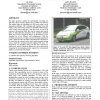Free Online Productivity Tools
i2Speak
i2Symbol
i2OCR
iTex2Img
iWeb2Print
iWeb2Shot
i2Type
iPdf2Split
iPdf2Merge
i2Bopomofo
i2Arabic
i2Style
i2Image
i2PDF
iLatex2Rtf
Sci2ools
GIS
2009
ACM
2009
ACM
From GPS Traces to a Routable Road Map
This paper presents a method for automatically converting raw GPS traces from everyday vehicles into a routable road network. The method begins by smoothing raw GPS traces using a novel aggregation technique. This technique pulls together traces that belong on the same road in response to simulated potential energy wells created around each trace. After the traces are moved in response to the potential fields, they tend to coalesce into smooth paths. To help adjust the parameters of the constituent potential fields, we present a theoretical analysis of the behavior of our algorithm on a few different road configurations. With the resulting smooth traces, we apply a custom clustering algorithm to create a graph of nodes and edges representing the road network. We show how this network can be used to plan reasonable driving routes, much like consumer-oriented mapping Web sites. We demonstrate our algorithms using real GPS data collected on public roads, and we evaluate the effectiveness...
| Added | 09 Nov 2009 |
| Updated | 08 Dec 2009 |
| Type | Conference |
| Year | 2009 |
| Where | GIS |
| Authors | Lili Cao, John Krumm |
Comments (0)

